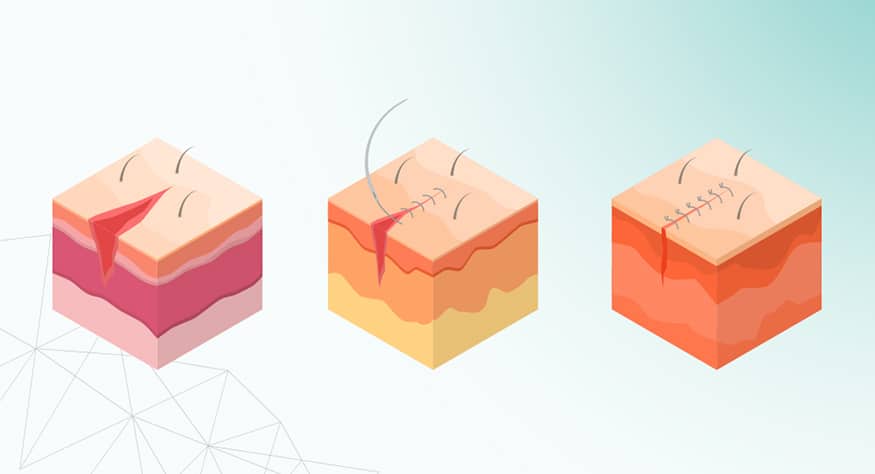

Prevalence
Non-healing surgical wounds include post-operative incisional dehiscence, surgical site infection (SSI) and post-operative incisions left open to heal by secondary intention. Surgical wounds account for 20% of all hospital skin infections.1 Most surgical wound infections present within the first month after surgery.2

Risk Factors
Break in surgical technique and prolonged operative time are common risk factors for development of surgical wounds.2 Older patients and those with multiple concurrent illness are most vulnerable.3

Pathophysiology
Multiple factors may contribute to non-healing surgical wounds including, pre-existing medical conditions, uncontrolled diabetes, malnutrition, immunosuppressive disorders and chronic steroid use. Trauma during surgery can decrease the viability of phagocytic cells, prolong the inflammatory phase, and increase the risk of infection.4

Assessment
Wounds can dehisce without surgical site infection. The diagnosis of SSI should be made using clinical signs and symptoms, cultures, and laboratory testing. Based on the risk of contamination and infection, surgical wounds are classified into four categories:
- Clean wounds: These wounds show no sign of infection or inflammation, and risk of infection is usually less than 2%.5
- Clean-contaminated wounds: These wounds also show no outward signs of infection. The risk of developing SSI with this type of wound is usually less than 10%.5
- Contaminated wounds: Infection is present or there is a major break in aseptic technique. The risk of infection with this type of wound is approximately 20-25%.5
- Dirty-contaminated wounds: wounds in which an infection is present at the time of surgery. The risk of developing SSI with this type of wound is high at nearly 40%.5

Prevention and Treatment
Surgical wounds typically heal by primary intention or closure using sutures. Good pre-and-post-operative wound management is recommended. Sutures and staples should be left in place for an adequate amount of time to establish wound closure; sutures in place for an extended period may pose risk for scarring and infection.6 All surgical wounds require a moist wound environment to support healing.7 Evidence suggest that use of negative pressure wound therapy (NPWT) may be beneficial for patients with non-healing surgical wounds.8 For patients at risk of malnutrition, nutritional supplementation should be considered.
References
- Loyola University Health System. Surgical site infections are the most common and costly of hospital infections: guidelines for preventing surgical site infections are updated. ScienceDaily. 2017. https://www.sciencedaily.com/releases/2017/01/170119161551.htm.
- Amenu D, Belachew T, Araya F. Surgical site infection rate and risk factors among obstetric cases of jimma university specialized hospital, southwest ethiopia. Ethiop J Health Sci. 2011;21(2):91-100. doi:10.4314/ejhs.v21i2.69049.
- Gould LJ, Fulton AT. Wound healing in older adults. RIMJ Archives. 2016: 34-36.
- Phillips, SJ. Physiology of Wound Healing and Surgical Wound Care, ASAIO Journal. 2000: 46(6): S2-S5.
- Herman TF, Bordoni B. Wound Classification. [Updated 2020 Feb 14]. In: StatPearls [Internet]. Treasure Island (FL): StatPearls Publishing; 2020 Jan-. Available from: https://www.ncbi.nlm.nih.gov/books/NBK554456/
- Azmat CE, Council M. Wound Closure Techniques. [Updated 2020 Jun 28]. In: StatPearls [Internet]. Treasure Island (FL): StatPearls Publishing; 2020 Jan-. Available from: https://www.ncbi.nlm.nih.gov/books/NBK470598/.
- WoundSource. Post-operative surgical wound management: key wound treatment considerations. 2018. https://www.woundsource.com/blog/post-operative-surgical-wound-management-key-wound-treatment-considerations#:~:text=All%20surgical%20wounds%20require%20a,technique%20should%20be%20strictly%20followed.
- Ge, D. The Safety of Negative-Pressure Wound Therapy on Surgical Wounds: An Updated Meta-analysis of 17 Randomized Controlled Trials, Advances in Skin & Wound Care. 2018: 31(9): 421-428.
